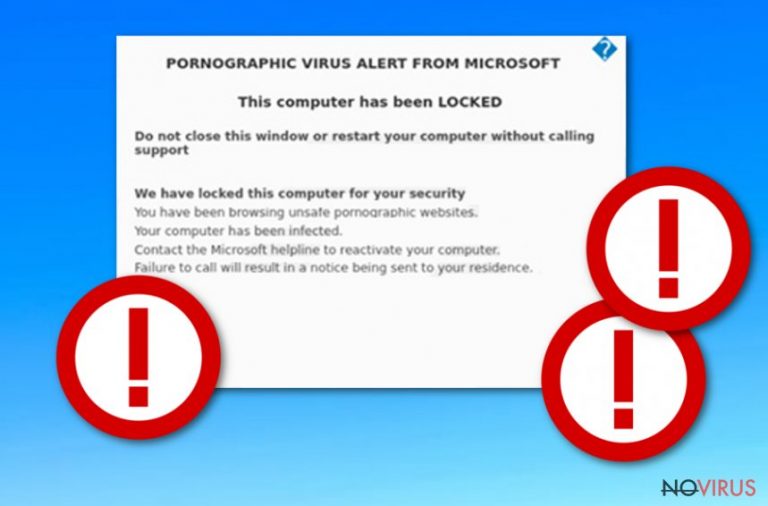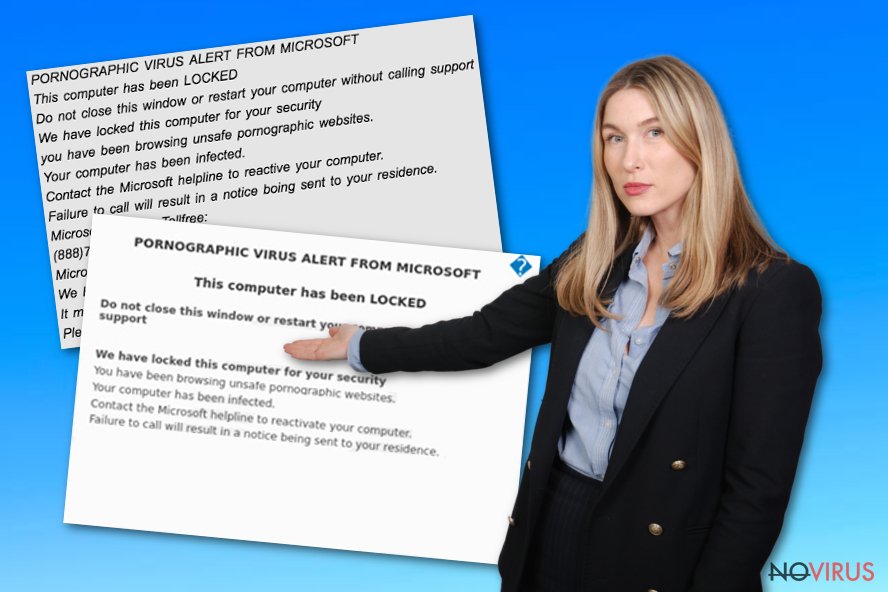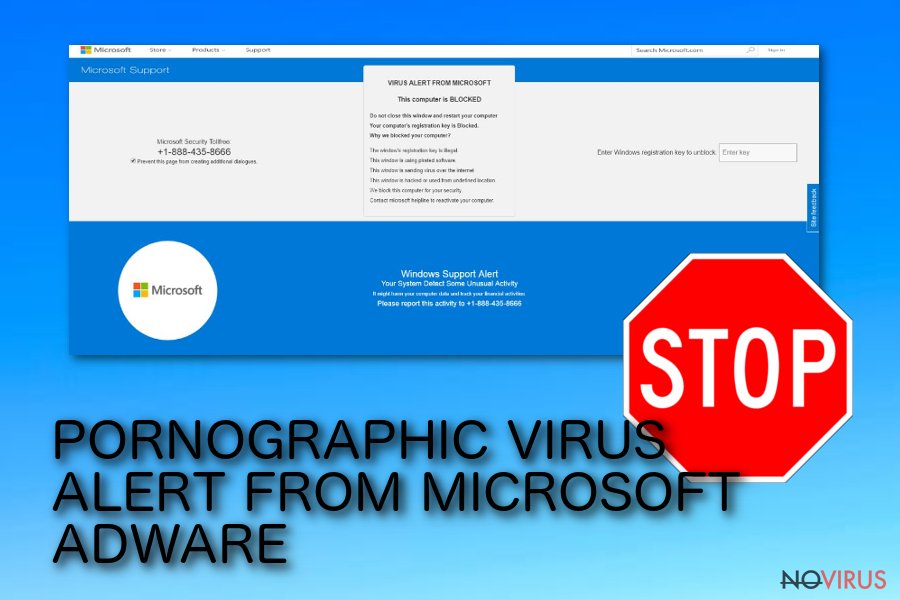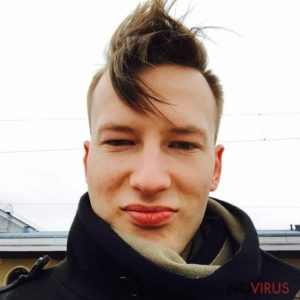Remove PORNOGRAPHIC VIRUS ALERT FROM MICROSOFT (Uninstall Guide) - May 2019 updated
PORNOGRAPHIC VIRUS ALERT FROM MICROSOFT Removal Guide
Description of PORNOGRAPHIC VIRUS ALERT FROM MICROSOFT
PORNOGRAPHIC VIRUS ALERT FROM MICROSOFT is the fake system message stating about malware to trick users into calling a provided phone number

PORNOGRAPHIC VIRUS ALERT FROM MICROSOFT is nothing but a technical support scam that is based on social engineering tactics. All those pop-up messages or even lock screens that fill up the display fully, shock and scare victims into calling the alleged support hotline. However, 888 732-1022 is not associated with Microsoft or any other legitimate technicians. Calling such number can lead to real problems and malware infiltrations while the pop-up message itself is not indicating any legal malware issues.
This alert is a scam, and since PORNOGRAPHIC VIRUS ALERT FROM MICROSOFT resembles other similar campaigns like Microsoft Warning Alert, there is no reason to call the provided number or contact criminals in different ways. One-time redirect is harmless, but calling these scammers may lead to loss of data or even money since they often ask for payment or subscription fee for the support service.
| Name | Pornographic Virus Alert From Microsoft |
|---|---|
| Type | Tech support scam |
| Similar | Microsoft Warning Alert |
| Tactics | Social engineering |
| Distribution | Software bundles deliver unwanted programs |
| Danger | Can lead to money loss, stolen personal data, malware infections, system damage |
| Elimination | Get FortectIntego and clean the device from potentially unwanted programs. Keep the tool running on the PC, so all the PUPs get blocked before entering the system |
PORNOGRAPHIC VIRUS ALERT FROM MICROSOFT scam focuses on tricking users into calling the phone number listed as the Microsoft technicians. Unfortunately, this scam is not connected with any legitimate companies, and there are no technical support employees who want to help you. Calling (888) 732-1022 can lead to scammers tricking you into allowing the remote access to the computer.
The initial Pornographic Virus Alert From Microsoft pop-up delivers the following message:
PORNOGRAPHIC VIRUS ALERT FROM MICROSOFT
This computer has been LOCKED
Do not close this window or restart your computer without calling support
We have locked this computer for your security
you have been browsing unsafe pornographic websites.
Your computer has been infected.
Contact the Microsoft helpline to reactive your computer.
Failure to call will result in a notice boing sent to your residence.
Microsoft Security Tollfree:
(888)732-1022Microsoft Support Alert
We Have Detected A Virus From A Pornographic Website
It might corrupt your data and track your financial activities.
Please report this activity to (888) 731-1022
This scam shows alerts stating about the possible malware activity, so people believe the PORNOGRAPHIC VIRUS ALERT FROM MICROSOFT message and contact scammers via the provided phone number. The primary goal of such campaigns is to trick people into employing scammer for technical help so the payment can be asked.
Also, people behind this Pornographic Virus Alert From Microsoft virus message may offer to fix system issues by entering the device remotely. Once the user allows such access, malware can be directly installed or malicious actors to get access and steal information directly from the computer.
Your computer hasn’t been affected by any malware and the only intruder, in most cases, is the initial PORNOGRAPHIC VIRUS ALERT FROM MICROSOFT scam. At the time of writing, this particular social engineering attack was especially active. The purpose of scaring people into paying for the alleged support or for keeping the secret of the fact that user watched pornographic content are the features that make sextortion and technical support scams similar. As harmless as it may seem, you need to get the professional anti-malware program and clean the system fully.

Unfortunately, Pornographic Virus Alert From Microsoft developers are not going to help you with the system issue. These alerts get pushed by many ad-supported sites and other programs categorized as potentially unwanted. Antivirus tools like FortectIntego cal help you eliminating them and ending the intrusive behaviour.
Don’t believe the message delivered on your screen and eliminate the adware that causes these alerts by performing an automatic Pornographic Virus Alert From Microsoft removal. You can clean your computer with a reliable anti-malware program and forget about these scary messages.
Make sure to remove Pornographic Virus Alert From Microsoft because such alerts are caused by rogue advertising sites and programs that run on the system without your knowledge. You can also become a victim of more severe malware campaigns or even identity theft of you allow these scammers to access your device and collect keystrokes when you transfer the payment for their “help”.
Pornographic Virus Alert From Microsoft is related to adware or a different PUP so you may encounter additional symptoms:
- pop-up advertisements and banners injected on commonly visited sites;
- redirects to commercial sites;
- installed browser extensions;
- slow performance of the machine and constant browser crashes.
Remember that Microsoft or Apple and other software providers, real technical support teams are not asking for money in exchange for their help. Also, such alerts with phone numbers or any additional contact information are not typical for real legitimate Microsoft system messages. Don’t fall for Pornographic Virus Alert From Microsoft scam and try to clean the system as soon as possible.

Insecure installations and deceptive pages with questionable content deliver PUPs and harmful material
You should note that visiting websites that are appearing out of nowhere can be dangerous because of the dubious content included on those sites and pop-up messages. Third-party advertisers include their content on various websites and aim to generate views on their sites by causing many redirects once the pop-up or banner gets clicked on.
When you install freeware or applications from generally non-legitimate sources like free download sites, p2p services or torrent networks you risk getting additional programs like PUPs, adware or even rogue tools. Choosing quick or recommended options automatically agrees to download and install all items on the list.
You can avoid these infiltrations if you go for Advanced or Custom installations and “unlock” the function that allows seeing the full list with all those extras. Also, choosing reliable sources, official software providers can help you avoid additional infiltrations.
Ensure the proper PORNOGRAPHIC VIRUS ALERT FROM MICROSOFT termination by using anti-malware tools
Tech support scams like this Pornographic Virus Alert From Microsoft virus, in most cases, are related to various files installed without your permission or knowledge. To get rid of the threat, you need to clean the machine thoroughly and delete all those files.
For that reason we have a guide below that helps to eliminate additional browser content that may affect the persistence of this PUP. For the direct Pornographic Virus Alert From Microsoft removal, we recommend relying on the professional anti-malware program.
Antivirus tools can perform a thorough system scan and help to remove PORNOGRAPHIC VIRUS ALERT FROM MICROSOFT. There is no need to manually find each associated files and program because the program automatically checks all the parts of the machine.
You may remove virus damage with a help of FortectIntego. SpyHunter 5Combo Cleaner and Malwarebytes are recommended to detect potentially unwanted programs and viruses with all their files and registry entries that are related to them.
Getting rid of PORNOGRAPHIC VIRUS ALERT FROM MICROSOFT. Follow these steps
Uninstall PORNOGRAPHIC VIRUS ALERT FROM MICROSOFT in Windows systems
Terminate suspicious programs from Windows 10/8 machines by following these instructions:
- Type Control Panel into Windows search and once the result shows up hit Enter.
- Under Programs, choose Uninstall a program.

- Find components related to suspicious programs.
- Right-click on the application and select Uninstall.
- Click Yes when User Account Control shows up.

- Wait for the process of uninstallation to be done and click OK.
Windows 7/XP instructions:
- Click on Windows Start and go to Control Panel on the right pane.
- Choose Add/Remove Programs.

- Select Uninstall a program under Programs in Control Panel.
- Click once on the unwanted application.
- Click Uninstall/Change at the top.
- Confirm with Yes.
- Click OK and finish the removal.
Chrome browser reset
Find and remove suspicious extensions from Google Chrome:
- In Google Chrome, open the Menu by clicking three vertical dots at the top-right corner.
- Select More tools > Extensions.
- Once the window opens, you will see all the installed extensions.
- Find any suspicious add-ons related to any PUP.
- Uninstall them by clicking Remove.

Clear cache and web data from Chrome:
- Click the Menu and select Settings.
- Find Privacy and security section.
- Choose Clear browsing data.
- Select Browsing history.
- Cookies and other site data, also Cached images and files.
- Click Clear data.

Alter settings of the homepage:
- Go to the menu and choose Settings.
- Find odd entries in the On startup section.
- Click on Open a specific or set of pages.
- Then click on three dots and look for the Remove option.
Reset Google Chrome fully:
You might need to reset Google Chrome and properly eliminate all the unwanted components:
- Go to Chrome Settings.
- Once there, scroll down to expand Advanced section.
- Scroll down to choose Reset and clean up.
- Click Restore settings to their original defaults.
- Click Reset settings again.

Delete PORNOGRAPHIC VIRUS ALERT FROM MICROSOFT from Safari
Get rid of questionable extensions from Safari:
- Click Safari.
- Then go to Preferences…

- Choose Extensions on the menu.
- Select the unwanted extension and then pick Uninstall.
Clear cookies from Safari:
- Click Safari.
- Choose Clear History…

- From the drop-down menu under Clear, find and pick all history.
- Confirm with Clear History.
Reset Safari fully:
- Click Safari and then Preferences…
- Choose the Advanced tab.
- Tick the Show Develop menu in the menu bar.
- From the menu bar, click Develop.

- Then select Empty Caches.
Delete PORNOGRAPHIC VIRUS ALERT FROM MICROSOFT from Microsoft Edge
Delete suspicious extensions from MS Edge:
- Go to the Menu by clicking on the three horizontal dots at the top-right.
- Then pick Extensions.

- Choose the unwanted add-ons on the list and click on the Gear icon.
- Click on Uninstall at the bottom.
Clear cookies and other data:
- Click on the Menu and from the context menu select Privacy & security.
- Under Clear browsing data, select Choose what to clear.

- Choose everything except passwords, and click on Clear.
Alter new tab and homepage settings:
- Click the menu icon and choose Settings.
- Then find On startup section.
- Click Disable if you found any suspicious domain.
Reset MS Edge fully:
- Click on the keyboard Ctrl + Shift + Esc to open Task Manager.
- Choose More details arrow at the bottom.
- Go to Details tab.

- Now scroll down and locate every entry with Microsoft Edge name in it.
- Right-click on each of them and select End Task to stop MS Edge from running.
When none of the above solves the issue, you might need an advanced Edge reset method, but you need to backup your data before proceeding.
- Find the following folder on the PC: C:\\Users\\%username%\\AppData\\Local\\Packages\\Microsoft.MicrosoftEdge_8wekyb3d8bbwe.
- Press Ctrl + A on your keyboard to select all folders.

- Right-click on the selection and choose Delete
- Right-click on the Start button and pick Windows PowerShell (Admin).

- Copy and paste the following command, and then press Enter:
Get-AppXPackage -AllUsers -Name Microsoft.MicrosoftEdge | Foreach {Add-AppxPackage -DisableDevelopmentMode -Register “$($_.InstallLocation)\\AppXManifest.xml” -Verbose
Instructions for Chromium-based Edge
Delete extensions:
- Open Edge and click Settings.
- Then find Extensions.

- Delete unwanted extensions with the Remove.
Clear cache and site data:
- Click on Menu and then Settings.
- Find Privacy and services.
- Locate Clear browsing data, then click Choose what to clear.

- Time range.
- Click All time.
- Select Clear now.
Reset Chromium-based MS Edge browser fully:
- Go to Settings.
- On the left side, choose Reset settings.

- Select Restore settings to their default values.
- Click Reset.
Delete PORNOGRAPHIC VIRUS ALERT FROM MICROSOFT from Mozilla Firefox (FF)
Remove suspicious Firefox extensions:
- Open Mozilla Firefox browser and click on the three horizontal lines at the top-right to open the menu.
- Select Add-ons in the context menu.

- Choose plugins that are creating issues and select Remove.
Reset the homepage on the browser:
- Click three horizontal lines at the top right corner.
- This time select Options.
- Under Home section, enter your preferred site for the homepage that will open every time you launch Mozilla Firefox.
Clear cookies and site data:
- Click Menu and pick Options.
- Find the Privacy & Security section.
- Scroll down to choose Cookies and Site Data.

- Click on Clear Data… option.
- Click Cookies and Site Data, Cached Web Content and press Clear.
Reset Mozilla Firefox:
If none of the steps above helped you, reset Mozilla Firefox as follows:
- Open Mozilla Firefox and go to the menu.
- Click Help and then choose Troubleshooting Information.

- Locate Give Firefox a tune-up section, click on Refresh Firefox…
- Confirm the action by pressing on Refresh Firefox on the pop-up.

Even if you have completed all the steps above, we still strongly recommend you to scan your computer system with a powerful anti-malware software. It is advisable to do that because an automatic malware removal tool can detect and delete all remains of PORNOGRAPHIC VIRUS ALERT FROM MICROSOFT, for instance, its registry keys. The anti-malware program can help you to easily detect and eliminate possibly dangerous software and malicious viruses in an easy way. You can use any of our top-rated malware removal programs: FortectIntego, SpyHunter 5Combo Cleaner or Malwarebytes.
How to prevent from getting adware
A proper web browser and VPN tool can guarantee better safety
As online spying becomes an increasing problem, people are becoming more interested in how to protect their privacy. One way to increase your online security is to choose the most secure and private web browser. But if you want complete anonymity and security when surfing the web, you need Private Internet Access VPN service. This tool successfully reroutes traffic across different servers, so your IP address and location remain protected. It is also important that this tool is based on a strict no-log policy, so no data is collected and cannot be leaked or made available to first or third parties. If you want to feel safe on the internet, a combination of a secure web browser and a Private Internet Access VPN will help you.
Recover files damaged by a dangerous malware attack
Despite the fact that there are various circumstances that can cause data to be lost on a system, including accidental deletion, the most common reason people lose photos, documents, videos, and other important data is the infection of malware.
Some malicious programs can delete files and prevent the software from running smoothly. However, there is a greater threat from the dangerous viruses that can encrypt documents, system files, and images. Ransomware-type viruses focus on encrypting data and restricting users’ access to files, so you can permanently lose personal data when you download such a virus to your computer.
The ability to unlock encrypted files is very limited, but some programs have a data recovery feature. In some cases, the Data Recovery Pro program can help recover at least some of the data that has been locked by a virus or other cyber infection.
